
| February 2002 | ||||||
| Sun | Mon | Tue | Wed | Thu | Fri | Sat |
| 1 | 2 | |||||
| 3 | 4 | 5 | 6 | 7 | 8 | 9 |
| 10 | 11 | 12 | 13 | 14 | 15 | 16 |
| 17 | 18 | 19 | 20 | 21 | 22 | 23 |
| 24 | 25 | 26 | 27 | 28 | ||
Tuesday 19 February 2002
At 1200, EST the Training Ship Empire State was located 135 nautical miles east of St. Augustine, FL, at 29 degrees and 49 minutes North Latitude and 078 degrees 50 minutes West Longitude, steering course 035 degrees true at a speed of 11 knots/Rpm 48 turns. The weather was partly cloudy, winds from the norhteast at 08 to 10 knots, air temperature was 67 degrees Fahrenheit, barometric pressure was 1023 millibars, seas were easterly at 5 to 6 feet, sea injection temperature was 76 degrees Fahrenheit. Depth of water beneath the keel was 410 fathoms.
CAPTAIN'S LOG
"Our progress as a nation can be no swifter than our progress in education. The human mind is our fundamental resource."
-John Fitzgerald Kennedy
Today we are to the east of the northern reaches of Florida. The sun has remained sequestered behind thick clouds for the last two days and the high temperature for the day has has not crossed into the 70's. We had NIGHTIME temps higher than that for a string of days when we were deep in the Caribbean. The evidence is in. Sea term 2002 is drawing to a quick close. Soon we will be shivering on the hook in Cape Cod Bay, watching our tans disappear under goose bumps big enough to hold the men's downhill ski race.
I know those of you intending to meet the ship need time to make arrangements so here are our current plans. We intend to sneak past Cape Hatteras, hopefully without the pounding we took last time we were here, and arrive off Sandwich in Cape Cod Bay sometime Friday, 22 February. Once there we will finish off the rest of the final exams, the STCW assessments, and the clean up. The weather looks good, so I see no problem with our entry to the Cape Cod Canal at noon on Sunday, the 24th, with an arrival off the MMA dock at 1251. We have already cleared customs, immigration, and agriculture when we stopped in Ponce so those details won't slow us down. It should take 20 minutes to get all of the lines out and the gangway rigged before the first people get to go ashore, so please be patient with us. We want to keep our safety record going and don't want an accident at the end to mar an otherwise great sea term.
Meanwhile, work continues unabated. Divisions 1 and 3 are hitting the books every night and reviewing their procedures so they can act confident when the Officer who assesses their skill quizzes them. Division 2 cadets are wondering why more work wasn't done on the way down. There is so much work staring them in the face at MOFO every day they swear the other divisions are filled with goldbricks. (That belief is soon disabused by their hold mates, but now everyone realizes how difficult it is to clean and care for 600 people while cleaning and maintaining a 38 year old steam ship.) Don't stand still too long on the fore deck or you will have a prime coat of white paint.
Speaking of work, here are some more examples of the great photo work by the Arnold/Ladden team that has made this sea term so enjoyable to watch from home.
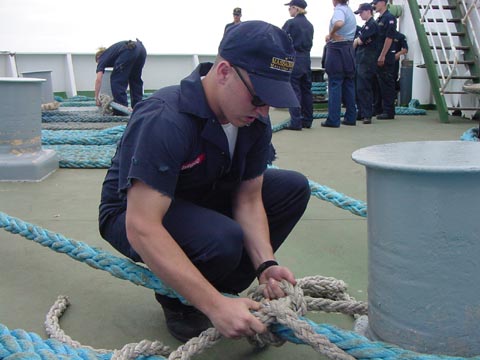
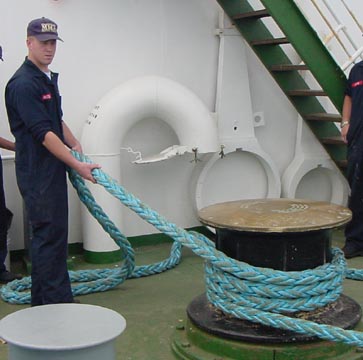
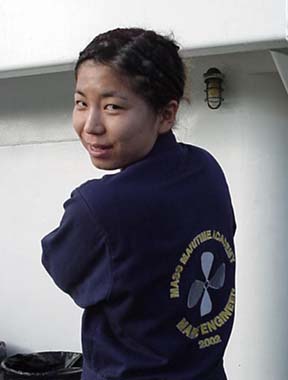
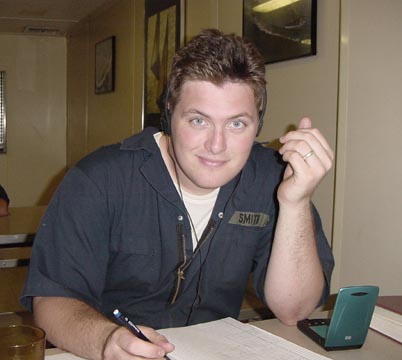
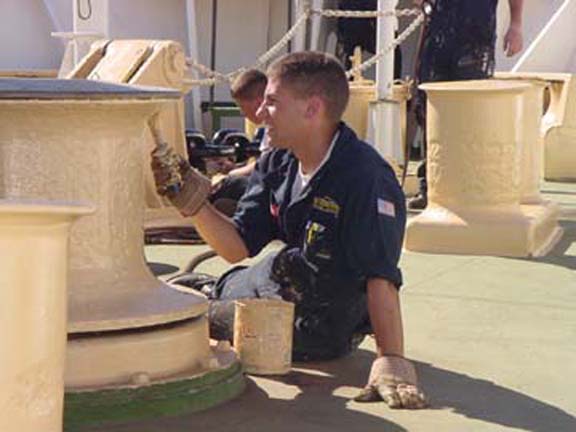
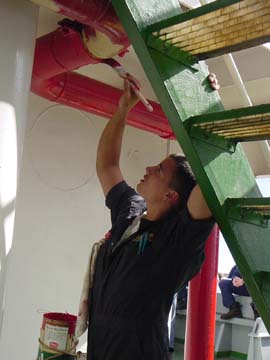
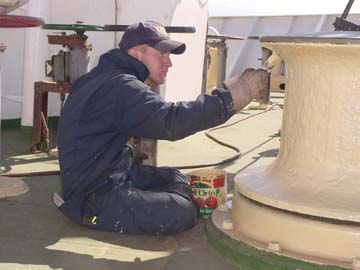
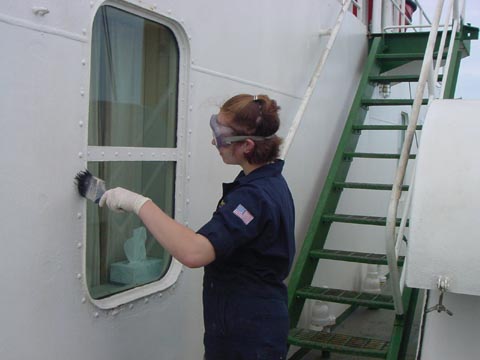
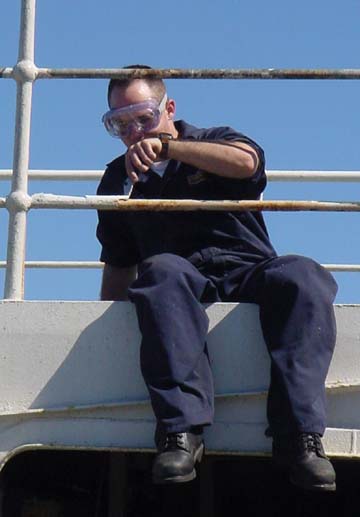
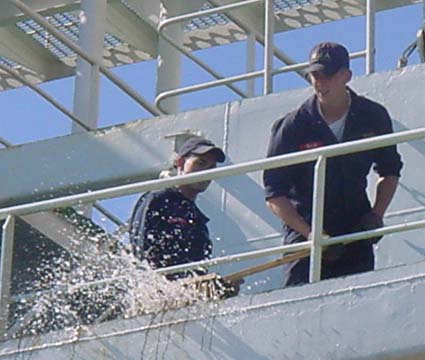
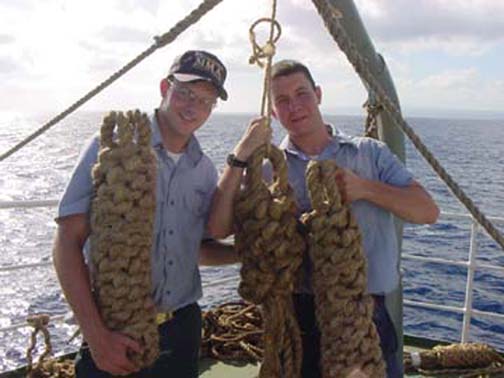
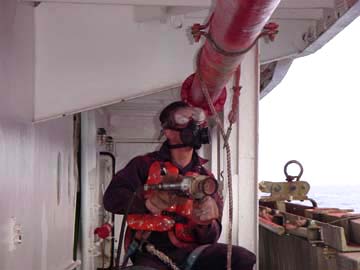
Finally, I must apologize for neglecting MY work. I forgot to post the daily questions and answers over the long President's Day Weekend. They follow the Cadet Comment section, for all those of you who love to match wits with Commander Curt Murphy, the creator of these daily mind games.
CADET COMMENT by Caryn Arnold and Katelyn Ladden
You know when we are almost home when the washers and dryers are all broken from overuse and abuse, the ice cream is all gone, everyone is down in the gym working out so they can shed a few pounds before returning home, and all the books in the library have been read. There are no longer any more Ping-Pong balls left that have not been damaged, Chartwell's food is the same everyday because we have run out of the good stuff, and the cadets and crew wish to be in the cold weather again so they can see their families.
On the other hand, last night was the talent show and the cheesy mustache contest. About 100 cadets showed up for the event despite the cold weather. The seniors are the only cadets that are allowed to grow mustaches, so every cruise there is a contest with cash prizes to see who can grow (or not grow) the cheesiest mustache. And the winner was..1/C Erik Jacobson, who received $100 for his efforts. His other opponents were Daryl Branch, Bob Ward, and Bob Butler. A sparse (pun intended) showing from the senior class considering all the people that TRIED growing a mustache.
The talent show started at 2000 with an introduction of the judges by 1/C Kevin Grechika, the announcer and Regimental Commander. The judges consisted of: Captain Joe Murphy (Marine Trans Prof), Lt. Heather Twiss (2nd Co. Officer), Ms. Linda Mac Gregor (Comcad secretary), Mike the chef, Chief Engineer Bill "Captain" Laffin, Roger the barber, and Ensign Mike Ott. Each judge rated the different acts on a scale of one to five, with the maximum score being thirty-five. (There was no collusion between the Deck and the Engine judge, as far as we could determine.) And this year, to the surprise of most, there actually was TALENT!
The opening act was performed by 3/C Heather Wickert and 1/C Maryellen Halloran. They sang a rendition of a song from the Broadway play "Rent". Next up, was the untalented duo of 2/C Tom Preston and 3/C Eric Muller who chugged ketchup and were booed off the stage. 4/C Brian McGauley was next. He entertained us by singing his version of "Beyond the Sea". Brian was followed by 4/C Elizabeth Remes, whose talent was performed through whistles. She started out with one and progressed to two whistles, although she could not keep her laughter under control...or the crowd's. The 5th Act was a little skit put on by 1/C Bob Ward, 1/C Andrew Booth, 1/C John Rob, 3/C Sean Gorman, 3/C Charles Goring, and Jill Dexter (Kitchen Staff). They were performing a take off of what goes on everyday on the stern by Proffessor Kris Jop and "Vic", the ship's Busun. The title of this production was "The One Who Got Away" and it ridiculed the fact that everyday, for the entire cruise, the two of them go to the stern and try to catch fish; Jop with his elaborate, expensive fishing rod and Vic with a piece of line and bait. Vic has no pole, he just ties off his line to the railing and leaves it there until he catches something... or not. In the play Vic got the big fish plus a mermaid and Jop fished out a boot and a miniature fish. It was quite amusing!
Amanda Lewis and Jodi Conklin , two galley personnel, followed the play. Jodi played the guitar while Amanda sang a very beautiful song called "Falling Angels". Next, 3/C Jason Rowan B-bopped for us on the microphone. 4/C Jonatas Silva presented the last act; he sang a song from the "Phantom of the Opera", and did a new age funk dance. The night was filled with laughter and booing. It was a fun night aboard the TSES and, like the gold medal in pairs figure skating, there was a tie for first place. "The One Who Got Away" and Amanda Lewis and Jodi Conklin both received $100. (Gold medals to follow.) A lot of credit goes out to all those who had the courage to get up on stage. I know the audience had a great time.
Tonight is Casino night in the mess deck. Wish me luck!
ANSWERS FOR FRIDAY 15 February 2002
MATH: 10 x .10 = 1.0
10 [^] 1.0 = 9 knots, Van Etten's speed.
9 x .10 = .9
9 + .9 = 9.9 Knots Ladden's speed
SCIENCE: Transformer
GEOGRAPHY: 1. Abacos Island 2. Long Island 3. Cat Island 4. Crooked Island
HISTORY: Englishmen who came from Bermuda seeking religious freedom settled the island of Eleuthera in 1647
QUESTIONS FOR MONDAY 18 FEBRUARY 2002
MATH: Cadet O'Rielly that the perimeter on the rectangle that he must paint is 38 inches. He wants to cut masking tape to fit the width. He knows that the length of the rectangle is 3 inches more than the width. Find the width.
SCIENCE: The Cadet Officer of the watch said that the waves were very powerful and 10 to 15 feet high. What do waves do in the ocean?
GEOGRAPHY: Florida is a wonderful place to take a vacation; it really appeals to tourists. Geography is all about what the people who live in a place do with what that place has to offer naturally. So, what are Florida's mineral resources? What kind of forests does Florida have?
HISTORY: Two black abolitionists, James Forten and Robert Purvis, were active in the leadership of a newly formed group lead by William Lloyd Garrison from New England. What did abolitionists believe about slavery? What was the name of the group established by Garrison in 1833?
QUESTIONS FOR TUESDAY 19 FEBRUARY 2002
MATH: If the numerator and denominator of a fraction are multiplied by 2, then the value of the fraction will be (1) Unchanged (2) Multiplied by 2 (3) Divided by 2 (4) Multiplied by 1/2
SCIENCE: The ocean waves routinely cause the ship to move up and down and side to side. Can one call that work?
GEOGRAPHY: A significant geographical feature will influence the ship for the next several days. This feature is found in the ocean, has a deep indigo-blue color compared to the dull green water around it, moves with great force, carries 75 times more water than all the rivers of the earth combined, and influences the climate of at least two continents. What is it?
HISTORY: During the Civil War, the Confederate States of America armed a number of vessels designed to hunt Union shipping and whaling fleets. These Confederate cruisers or raiders could be found in waters all along the Atlantic Coast as well as in the Pacific. Which raider was sunk by the U.S.S. Kearsarge off the coast of Cherbourg, France on June 19, 1864? Which Confederate raider became famous for attacking the Pacific whaling fleet? Which raider was captured in the port of Bahia, Brazil in October 1864?
ANSWERS FOR MONDAY 18 FEBRUARY 2002
MATH:
Perimeter means the sum of all the sides. Let n = the width Then n + 3 = the length The perimeter = n + n + 3 +n +n + 3 or 4n + 6
4n + 6 = 38 4n = 3 n = 8 (width)
SCIENCE: The waves transfer energy through the ocean
GEOGRAPHY: Florida's mineral resources are phosphate rock, sand and gravel (pretty boring!). Florida's forests are primarily yellow pine (not too exciting). I guess that is why they do a lot with their sunshine
HISTORY: Abolitionists believed that slavery should be ended (abolished). They sometimes disagreed about how this should be accomplished. The name of Garrison's organization was the American Anti-Slavery Society
QUESTIONS FOR WEDNESDAY 20 FEBRUARY 2002
MATH: The Ship was well ahead of schedule and the reserved parking space at the pier was not ready. The Cadet Officer of the Watch decided to turn the ship in a large circle until the space became available. She told the navigator that she wanted to travel the circumference of a circle with a radius of 21 nautical miles. How far would the ship travel if in one revolution?
SCIENCE: The Cadet Engineer of the Watch is also concerned with waves. He said that sound waves coming from the engine room were very intense. He asked the Marine Safety Cadet to measure the intensity. What units are used to measure the intensity of sound?
GEOGRAPHY: Not far ahead of the ship is an area well known for rough water, wild weather and ship wrecks. Cape Hatteras is infamous for maritime disasters. From a geographer's point of view, what is a cape? How does it differ from a peninsula?
HISTORY: Do you remember our pirate friend Edward Thatch (or Teach) - Blackbeard? Well, his vessel was lost in the waters off North Carolina in the early 1700's. It seems he ran aground on a sand bar off Topsail Inlet, now called Beaufort Inlet. His ship was lost, along with another that was going to pull him off the sand. What was the name of Blackbeard's vessel?
ANSWERS FOR TUESDAY 19 FEBRUARY 2002
MATH: If the numerator and denominator are multiplied by the same number (except zero), the effect is to multiply by 1, so the fraction is unchanged.
SCIENCE: Work is the transfer of energy through motion: work = force x distance. The ship moves in the direction of the force so work is accomplished
GEOGRAPHY: The Gulf Stream.
HISTORY: The U.S.S. Kearsarge sank the Alabama in the waters off France. The raider famous for attacking the whaling fleet was the Shenandoah. The Florida was captured in Brazil by the U.S.S. Wachusett.